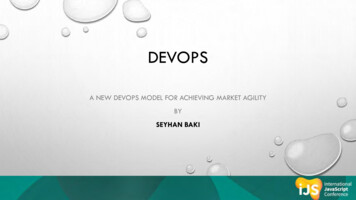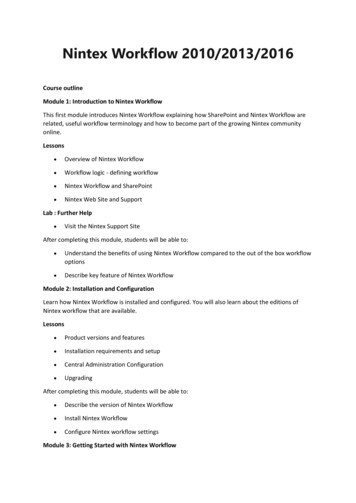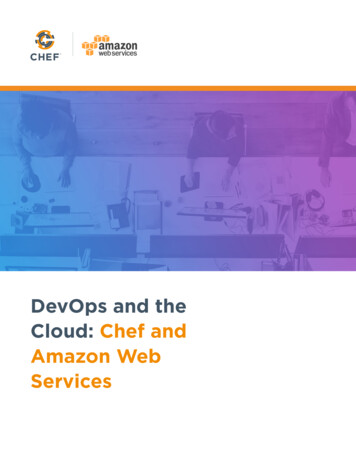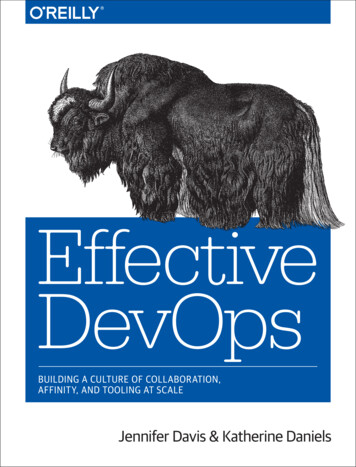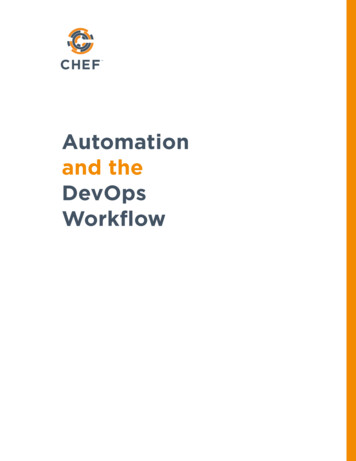
Transcription
Automationand theDevOpsWorkflow
Copyright 2015 Chef Software, Inc.http://www.chef.io10/2015
Automationand theDevOps WorkflowExecutive SummaryThe advent of the digital economy has fundamentally changed consumption patterns.Today’s customers are accustomed to goods and services that are available onlineanytime, anywhere and from any type of device. To satisfy these new expectations,every enterprise must transform the way it does business or risk obsolescence. Enterprise IT, once considered a back office support function, must become the frontoffice connection to customers and the linchpin of a mission-critical transformation.Innovative companies such as Amazon, Google, and Facebook have set thepattern for this transformation. These innovators, along with an active community ofweb practitioners, have developed a workflow and set of practices, encapsulated bythe term DevOps, that brought about many technical and cultural changes to IT andresulted in infrastructures and applications that were extraordinarily fast and scalable.The hallmarks of a DevOps workflow are velocity, consistency, scale and theability to incorporate feedback.VELOCITYCONSISTENCYSCALEFEEDBACKDevOps is at the heart of becoming a software-led company, and it is no longerfor the select few. DevOps is becoming the norm for how enterprises handle change,whether to their infrastructure or to their applications.However, established enterprises have a challenge that the DevOps innovatorsdid not. They have legacy workloads and regulatory requirements to consider. Migrating these workloads to a flexible technology stack must be done in a way that reduces risk, ensures stability and guarantees regulatory compliance. In addition,established enterprises have existing processes for managing change, that ofteninvolves many manual steps. These processes must be replaced by a more automated and collaborative workflow.This paper focuses on the technical attributes of automation and the DevOpsworkflow and shows how they help you meet the demands of the digital economy.1
Every Business Is SoftwareEvery business is a software business, no matter what industry it’s in. Customers,whether outside the corporate firewall or behind it, have higher expectations forspeed, reliability, and personalized content. They expect fast response times andgreat customer service.These expectations exist because innovative online companies such as Amazon, Google, and Facebook constantly raise consumer expectations. Any businessthat wants to remain competitive must emulate the patterns developed by the webinnovators, which are summarized by the term DevOps. Following DevOps patternsallows companies to quickly respond to customer demands with the software thatprovides the experience customers want.Fast response to consumer demand requires a technology stack that can reactquickly to changing business needs while maintaining its resiliency and reliability, andit requires the ability to deliver new application features just as quickly.Defining DevOpsWeb innovators discovered that to promote agility and speed, IT and developmentmust work together to build a technology stack that can safely support rapid deployments and dynamic workloads.These innovators combined software developers and IT professionals into unified teams aligned around shared business goals. These teams use a workflow thatrelies, technologically, on automation and socially, on collaboration. This new way ofworking makes it possible for companies to develop infrastructure and applicationsthat respond quickly to change while remaining stable and reliable. The new processalso enables much faster and more reliable delivery of application features.As the new way of working disrupted the conventional thinking that had shapedIT operations in the past, DevOps became the accepted name used to describe it.Today, DevOps can be thought of as the tools, processes and culture that are centralto becoming a software-led organization.Time tomarketComplexityDimensionsof ScaleNumber ofserversStaffDevOps PatternsOne of the goals of DevOps is to create a compute environment that supports rapiddeployment, and has the ability to react swiftly and effectively to changes in businessrequirements. These attributes scale even as the overall system becomes larger andmore complex.2AUTOMATION AND THE DEVOPS WORKFLOW
There are some general patterns that characterize how DevOps practitionersachieve this goal. Here are some of the patterns.DevOps practitioners focus on the digital customer experience. All the technology they invest in and the innovations they create are a means for delivering a greatcustomer experience. These customers can exist eitheroutside or inside of the firewall.We start with the customer and work backwards.1DevOps practitioners collect data. Web innovatorsare great believers in data and collect it on everythingthey can as often as they can. They improve their processes based on evidenceprovided by the data they collect. The data helps them understand what’s workingand what isn’t.– Jeff Bezos, Amazon.comDevOps practitioners invest in technical innovation. Successful online companies encourage innovation, and the investments don’t have to be large.Intuit is a great example of a company that encourages innovation. Intuit givesemployees 10% of their hours as unstructured time. The legal department created atoolkit that lets product managers try new business ideas without needing to talk tolegal. Intuit’s IT department leveraged a DevOps workflow to accelerate the setuptime for test environments for new web products from two months to two hours.DevOps practitioners use open source software and dynamic infrastructure.A reliance on open-source software is typical in DevOps environments.DevOps practitioners also rely on dynamic infrastructure where resources areprovided on demand to the company’s business units, with service-level agreementsthat guarantee some level of quality in areas such as availability, performance andsecurity. Individual departments needn’t be responsible for planning capacity; instead, capacity planning occurs at the corporate level and is aligned to the needs ofthe business.The incentive to use open source software and commodity hardware, and toprovide infrastructure as a service (IaaS) is not necessarily cost—it’s the ability tocustomize and control the technology stacks and respond quickly to business needs.DevOps practitioners tend to use service-oriented architectures. Factoring applications into stable, independent services that use web protocols and associatedarchitectural patterns is very common in the DevOps world. Each service can beindependently implemented, deployed, and scaled. As a result, teams becomealigned to business functions rather than divided into silos that isolate technical specialties from each other and put drag on the ability to deliver value.DevOps practitioners improve through multiple iterations. Amazon, Google andFacebook don’t wait until they’ve built what they think is the perfect product only tofind out that what they’ve done isn’t what the customer wants. Instead, they start witha minimal implementation and build it incrementally. They use A/B testing to find outwhat works and what doesn’t. In 2011, Google ran more than 7,000 A/B tests on itssearch algorithm. Amazon.com, Netflix, and eBay are also A/B advocates, constantly testing potential site changes on live users.DevOps practitioners avoid silos through transparency. Silos are not just organizational divisions but informational ones as well.When Nordstrom used DevOps principles to build a continuous delivery pipeline,they put developers, web site operations engineers, QA engineers, and configurationmanagement together to form a single team. The team combined expertise acrossmultiple technical disciplines and retained focus and accountability by holding weekly demos. The end result of all that transparency is that now people all over thecompany, even people in the finance department, email senior vice presidents, asking how can they help with continuous delivery.AUTOMATION AND THE DEVOPS WORKFLOW3
Increased communication has many obvious benefits. Within a team, membersquickly learn about proposed changes and any problems that exist. Involving a number of different stakeholders, such as product managers, members of the sales force,and consulting can bring in valuable information from areas outside the team members’ areas of expertise. Making information available to everyone in the companygives employees a sense of ownership and participation.DevOps practitioners deploy software very quickly. Part of the reason DevOpsteams move so quickly comes from their belief that failure is expected in a culturethat innovates and moves rapidly. However, they don’t want to fail after having spentmonths on a product. Instead, they use a very fast stream of incremental releases sothat, when there is a failure, it’s easy to correct and their investment is small. A flexible, managed infrastructure allows them to quickly put together prototypes and testthem. Automated processes, such as continuous integration and continuous delivery,make deployment and change management faster and more reliable.DevOps practitioners build compliance into the software deployment pipeline.Instead of being tacked on at the end of the production process, compliance is embedded into the software production line. Compliance at velocity uses extensive automation to increase velocity and accuracy.For example, GE Capital (GEC) realized that, to remain competitive, it neededto streamline the way it developed, delivered and maintained software. At the sametime, GEC operates in a highly regulated environment and is obligated to comply withmany requirements. GEC’s challenge was one that many large enterprises face: Howdo you remain compliant and still operate atvelocity?“Steve Blank and Eric Ries, both serial entrepreneurs,For GEC, the answer was DevOps. To ensure that compliance was an integral part ofhave studied what allows businesses such as Google tothis new software delivery process, theysucceed in today’s quickly changing world. They foundbrought the regulatory, compliance, goverthat the companies that succeed in dynamic marketnance, and security teams in early to take tollplaces are those that rapidly develop products withgates out and get rid of manual processes sominimal planning and commitment of resources.”6they could deliver at velocity and at the sametime remain compliant and secure.DevOps practitioners use version control. Version control systems give transparency to all aspects of orchestration, configuration and deployment. With version control team members can review the history of all change sets at any time.DevOps practitioners rely on automation. An automation platform gives you theability to describe your entire technology stack as executable code. DevOps practitioners use automation to: Standardize development, test and production environments. Effectively deploy and manage cloud resources. Eliminate error-prone, time-consuming manual tasks. Improve cooperation between development and operations. Implement automated release pipelines.4AUTOMATION AND THE DEVOPS WORKFLOW
What is Automation?Automation gives you immediate access to the same patterns of success that theweb innovators had to develop themselves.When you automate your technology stack, you describe it with executable code.For example, here’s how you can use the Chef automation platform to ensure thatthe Apache web server package is installed and being run as a service on a RHELor CentOS server.package 'httpd'service 'httpd' doaction [:enable, :start]endThis code tests to see if Apache is installed and running. If not, it installs theApache package, called httpd, enables the service and starts it when the serverboots. The code is also readable by humans so that team members have a sharedunderstanding of the system’s intended state.If you’re not using an automation platform, you might perform these tasks byhand. If it’s a manual task, imagine what it would be like if you had to do the sameprocedure for 50 servers, 500 servers or even 50,000 servers. With automation, yousimply run the code as often as needed.Automation platforms have significant advantages over isolated scripts that havetraditionally been used for system administration tasks. Platforms like Chef take careof many of the complexities of configuring a server for you. Chef recipes have aglobal view of your network because they interact at run time with the Chef server,which is important when accounting for dependencies between network components. Standalone scripts can only give you a piecemeal view.Full-stack automation can revolutionize the way your teams work together. Withit, the same practices you follow to ensure the quality and manageability of yourapplications can now be applied to your infrastructure and all of the services in thestack. You can faithfully encode your entire technology stack in version control, andyou can test it. If you lose part of your infrastructure or even all of it, you can recreateit by rerunning the code that describes it. Assessment CollaborativeDevLocal DevProduction Revision ControlBenefits of automationAutomation enables velocity, scale, consistency and feedback. All of these qualitiesare of a piece. Any one depends on the other three—for example, you can’t scaleunless you are able to quickly add servers with consistent configurations. You can’tget feedback automatically without being able to support different real-time testingand monitoring techniques. You can’t respond to feedback effectively unless you havea high-velocity way to deliver incremental changes safely.AUTOMATION AND THE DEVOPS WORKFLOW5
V E LO C I T YAutomation increases velocity in many ways. Simply replacing manual procedureswith automated ones makes infrastructure management more efficient. However, asyour use of automation becomes more sophisticated, you’ll find that you’ll markedlyincrease your deployment rate and the ease with which you manage all your resources, both on premises and in the cloud. Automation makes techniques such as A/Btesting possible. You can quickly find out what works for your customers before investing huge amounts of time and money. Quick response to changing businessneeds is essential.SCALEAutomation allows you to scale up (or down) in response to demand. Automation isa critical component of any strategy that requires dynamic provisioning of infrastructure at scale. Automation enables elastic scale, whether you’re operating on premises, in the public cloud, or in a hybrid environment.CONSISTENCYAutomation ensures consistency across your network. Consistency means conformance to your business’s policies. An automation platform checks to make sure thateach server is within policy and corrects it if it isn’t. In other words, a good automationplatform must make it easy to prevent configuration drift over time.When you represent [infrastructure] in code, you canConsistency makes infrastructure moreversion that code, and you can say, “This is what therobust and reduces risk in many ways.The immediate benefit is that you have a stanmachine looks like today and this is what it looked likedardized process for provisioning servers.last week, and this is when somebody changed it.”A consistent environment makes it muchWhen you have that, you can almost print these neweasier to migrate applications to the cloud.machines like you have a factory press. You just putConsistency gives you control, and controlthe code in and Chef takes care of it. Chef prints outreduces risk. With automation, moving legabrand new machines for you, faster than ever.7cy applications to the cloud is an orderly—Jamie Winsor, software engineer, Riot Gamesprocess.Requirements for an automation platformTo provide the foundation for building and managing infrastructures according to theprinciples of DevOps, a good automation platform has these essential characteristics: It creates a dependable view of your entire network’s state. It can handle complex dependencies among the nodes of your network. It is fault tolerant. It is secure. It can handle multiple platforms such as RHEL, Ubuntu and WindowsServer, as well as legacy systems. It can manage cloud resources. It is the basis for an efficient workflow. It provides a foundation for innovation.Let’s examine these points in more detail.Your automation platform should create a dependable view of your network. Agood automation platform knows the state of your entire network at any given time.You need a global view of your network. Scripts can’t provide this capability.6AUTOMATION AND THE DEVOPS WORKFLOW
Your automation platform should handle complex interdependencies. Most infrastructures have many dependencies between servers. For example, a load balancer needs to know when a new application server is available. Isolated scripts can’thandle complex dependencies that require distributed coordination.Implementing distributed coordination requires specialized techniques that takea holistic view of the network. It’s more than just running scripts or deploying “goldenimages.”A good automation platform will allow the network to converge to its desiredstate over time and provide search-based configuration that allows nodes to querythe automation platform for information about other nodes in the network. This issometimes called policy-based convergence.Your automation platform should be scalable. Infrastructures tend to becomelarger and more complex over time. To ensure scalability, a good automation platformwill have a distributed, rather than a centralized architecture. With a centralized architecture, most of the work occurs on the server, which can become a bottleneck asnetworks grow. With a distributed architecture, the work occurs on the nodes, and anode only has to take care of its own configuration.Your automation platform should be fault tolerant. A good automation platform isable to recover when network connections go offline or when a system needs to berebooted. It should also be able to handle errors and unexpected conditions. A goodautomation platform will eventually converge to the desired state, even if faults occur.Your automation platform should be secure. A good automation platform ensuresthat communications between the server and the nodes are secure. It enables granular control over who can access different resources.Your automation platform should handle multiple platforms. Many infrastructures include multiple operating systems. For example, there may be Windows, AIXand Linux machines in the same network. A good automation platform supportsheterogeneous networks.Your automation platform should handle legacy systems. Most infrastructuresinclude legacy systems that don’t fit any standard configuration model. An automationplatform should be extensible and not just a set of fixed capabilities.Your automation platform should be able to manage cloud computing environments. A good automation platform is cloud capable and provides the structure andconsistency needed to make moving legacy workloads to the cloud a low-risk operation.AUTOMATION AND THE DEVOPS WORKFLOW7
Your automation platform should automate your workflow, not just your infrastructure. DevOps is a new way of working together safely and at high velocity. Yourautomation platform needs to understand the demands of the DevOps workflow andhelp you replace cumbersome change management processes with proven, modernapproaches taken from the experience of web innovators.Your automation platform should provide a foundation for innovation. Even ifyou’re automating basic configuration tasks now, what do you want to be doing a yearfrom now, or five years from now? You need a platform that meets your present needsbut won’t limit you as you grow.Why Chef?Chef8 is the automation solution for the DevOps workflow. Chef was born with theDevOps movement, and experience with DevOps thinking and best practices havebeen distilled into every aspect of Chef.Chef is IT automation platform for DevOpsOnly Chef is a dynamic, policy-based automation platform that securely distributesintelligence across the entire network. What does this mean? It means that Chef has a unique ability to scale, from start-ups to Facebook to GE. Chef has a unique ability to ensure consistency in complex, highly dynamicenvironments. Chef is fault tolerant. Chef grows with you. When it comes to solving configuration and automationchallenges, Chef makes the easy things easy and the hard things possible.C H E F I S H I G H LY S C A L A B L EChef is constructed so that most of the computational effort occurs on the nodesthemselves rather than on the Chef server.With Chef, the intelligence about the desired state of the network is distributedacross the network itself. Each node of the network periodically executes the currentinstructions from the Chef server. This iterative process ensures that the network asa whole converges to the state envisioned by business policy.Request current policyPolicyPolicy and network stateStateAutomation Server8AUTOMATION AND THE DEVOPS WORKFLOWCurrent node stateNode
Chef is the only automation platform that usesa fully distributed approach, and this has someimplications that make it uniquely suited for themassive scale of today’s applications. Chef’sunique ability to scale is one of the reasons Facebook uses Chef for its production systems.CHEF CAN HANDLE COMPLEX,H I G H LY DY N A M I CENVIRONMENTSThere are three dimensions of scale we generallylook at for infrastructure – the number of servers,the number of different configurations across thosesystems, and the number of people required tomaintain those configurations. Chef provided anautomation solution flexible enough to bend to ourscale dynamics without requiring us to change ourworkflow.9—Phil Dibowitz, Production Engineer at FacebookChef has a unique ability to ensure consistency incomplex, highly dynamic environments. This is aweak spot of a centralized approach where a server blocks while waiting for aresponse from a node, or of an approach where logic executes on the server.Chef handles bidirectional dependencies. If a network uses database replicas,each replica must know about the others in order to remain in sync. Symmetric dependencies such as these create a sequencing problem that can only be solved byusing policy-based convergence. Full configuration doesn’t occur in a single step, butthe network as a whole eventually converges to its desired state.Chef handles reboots and network resets. Centralized approaches that rely onlong-lived network connections break down when the networking service goes offlineor the system needs to be rebooted as a part of the requested operation. A moredistributed approach, where the node itself initiates contact with the server, allowsthe node to update state after coming back online. The Chef server can orchestratea complex series of operations, even when nodes under management require network resets or must reboot as part of the process.Chef is fault tolerant. When intelligence is distributed to the nodes, appropriate recovery measurescan be taken when an error or unexpected condition occurs. It is more difficult for a centralizedserver to respond in this case.Chef is secure on every type of network. Chefuses SSL to ensure that a Chef server respondsonly to requests made by trusted users. When anode is configured to run the Chef client, bidirectional validation of identity occurs between theChef server and the newly added node. Thismakes Chef suitable for managing nodes on everytype of network, even public networks.By bringing in Chef, we were able to automate a veryheterogeneous infrastructure that included both legacyand new applications and we were able to open upsome interesting career paths for our engineers. Wehave hardcore UNIX engineers now happily automatingWindows infrastructure because they can do it throughcode.10—Rob Cummings, Infrastructure Engineer, NordstromChef supports multiple platforms and legacy systems. Chef supports many flavors of Linux and Unix, as well as Windows Server. For example, Chef includessupport for Microsoft’s Desired State Configuration (DSC) PowerShell extension.Chef also supports containers. With Chef, engineers can use the same skill set tomanage every platform in your network.Chef comes with a large number of pre-defined building blocks, called resources,which describe pieces of infrastructure, such as files, templates, and packages. TheChef community has also written many collections of configuration instructions calledcookbooks, which cover many situations.However, if you need to write your own configuration steps for a particular system, you can do it with Chef. Chef isn’t constrained by a limited, domain-specificlanguage. You have the flexibility you need to describe any piece of infrastructure youhave.AUTOMATION AND THE DEVOPS WORKFLOW9
Chef can manage cloud resources. If you’re already in the cloud or thinking aboutmoving some servers there, Chef has proven to be a great way to manage your resources. For example, Cycle Computing uses Chef to manage tens of thousands ofpublic cloud nodes. A large percentage of customers use Chef to automate andmanage cloud resources.Chef enables test-driven infrastructureWhen your infrastructure is described as code, you can treat that code just as youwould your application source code. For example, do you have unit tests for yourapplications that are initiated automatically whenever there is a check-in to yourversion control system? You can now do the same with your configuration code.With automated testing, you will catch problems earlier, before they impact yourrelease cycle. The earlier you catch a problem, the easier and less expensive it is tofix, and this is why testing is such an important part of DevOps practice.The V-diagram, common in software engineering, illustrates esignIntegrationtestingCodingUnittestingAs you can see, each kind of testing activity (on the right side of the V) checksa particular phase of development (shown on the left side). The cost of rework risesas defects are discovered later in the project. It’s better to begin testing at the vertexof the V, with unit tests. Catching a defect during a unit test is much easier than tryingto fix it when it’s being tested with other components that might make it difficult todiscover where the actual problem lies.The practice of automatically testing your infrastructure code is called test-driven infrastructure. Testing the code that provisions andWe’re looking at cloud architecture. We’re looking atconfigures your infrastructure gives confidencepublic cloud, we’re looking at private cloud. We wantthat your infrastructure will behave as it shouldto do some completely different things that we haven’twhen put into the production environment.been able to do before. The only reason that I’m ableChef has a strong commitment to test-drivento consider those is because of what we did with Chef.infrastructure as part of the DevOps workflow. InIt’s now opened a completely new capability that Ifact, it is the only company that provides commercial support for a full suite of tools for test-drivenhadn’t foreseen. I view Chef as the tool that has hadinfrastructure.the single biggest impact in our transformation.11The following diagram shows how you can—John Esser, Director of Engineering Productivityand Agile Development, Ancestry.comuse the different tools Chef provides to test yourcode at all stages of development.Create newskeletoncookbook10Create a VMenvironmentfor cookbookdevelopmentAUTOMATION AND THE DEVOPS WORKFLOWWrite/debugcookbookrecipes(iterative step)PerformacceptancetestsDeploy toproduction
Chef automates enterprisechange managementCode has given us a single way to communicate.Before we had different groups operating with differenttools, and different mindsets in how they approachedthings. By distilling it all down to code, we’re able toleverage the same practices among different groups.It allows us to be more agile, move faster and respondwhen the business needs us to respond.12The DevOps workflow allows you to safely andrapidly deploy changes to applications and infrastructure. However, it can be challenging to implement the actual pipeline that moves your codefrom development to production. Not only must thepipeline’s design address technical challenges,—Rob Cummings, Infrastructure Engineer, Nordstrombut it should also encourage practices that support a DevOps workflow. Those practices are alarge part of the reason that DevOps make it possible to quickly move code out to production andrealize its value.Integrating DevOps practices with automation is the foundation of a new approach to enterprise change management. Chef Delivery, a recent addition to theChef platform, is an example of such a system. Its design is based on Chef’s yearsof experience with its enterprise and big web customers. You use Chef Delivery forboth your infrastructure and application code, giving your operations and development teams a common platform for developing, testing and deploying cookbooks andapplications. Chef Delivery also incorporates DevOps best practices, such as usingsource control and automated testing, into its design.Here is the Delivery workflow:The first step of the workflow is to create a change on a developer’s workstation.The next step is to test the change locally using the automated tools described abovein the section “Test-Driven Infrastructure.” While it is still a new practice to manypeople, local testing is an excellent way to discover bugs early in the developmentprocess, when they are easier and cheaper to fix.Once a change passes local tests, the person making the change commits itusing the revisi
the term DevOps, that brought about many technical and cultural changes to IT and resulted in infrastructures and applications that were extraordinarily fast and scalable. The hallmarks of a DevOps workflow are velocity, consistency, scale and the ability to incorporate feedback. Automation and the DevOps Workflow




